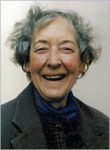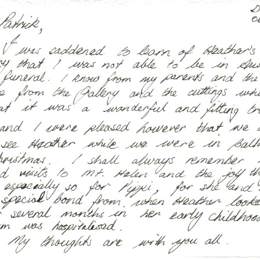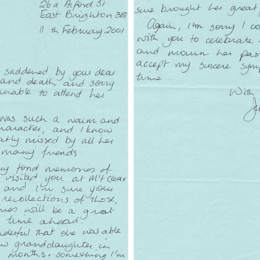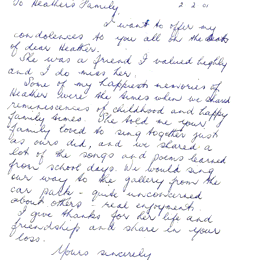Anecdotes & Reminiscences
Obituary in The Age
Heather Willison Irwin
Social Worker, 26-6-1925 — 30-1-2001
By Julia Irwin (Heather Irwin's daughter)
Heather Irwin devoted almost half a century to fighting for social justice in the Ballarat district. She was a voluntary social worker for Red Cross in the early '60s before taking a paid position with the Department of Social Security in the '70s where she worked until her retirement in the late '80s.
In her work, Heather favored action rather than rhetoric. She threw herself into helping people and could often be seen driving across Ballarat late at night distributing blankets and clothes to people who had been affected by bushfires or other crises. When emergency relief was slow to come, Heather would often take money out of her own purse to ensure there was food on the table of those in need.
In 1978, Heather founded the VIP (Very Interesting People) flower shop at the Ballarat Health Service Base Hospital. The flower shop, later named in her honor, provided meaningful and creative work for more than 50 women; many of whom were like herself, alone after children and husbands had left home. It gave these women a social outlet and often a boost to their self-esteem. The flower shop was also a lucrative fundraiser for the hospital, having raised more than $150,000.
Heather was a founding member of the Ballarat Fine Art Gallery's volunteer guide group. She regularly guided visitors around the gallery from 1983 until last year. She also instigated monthly lunchtime talks, inviting artists holding exhibitions to discuss their work.
Heather Irwin (nee Cochran) was born into an old Ballarat family. Her ancestors arrived at the Ballarat goldfields before the Eureka rebellion. Her grandparents were born in tents on the diggings.
She was educated at Pleasant Street Primary School before winning a scholarship to Clarendon Presbyterian Ladies' College where she was dux of the school two years running and head prefect in her final year.
She had a fine soprano singing voice and sang alongside world famous opera singer Elsie Morrison in the St Andrew's church choir.
In 1944, Heather won a scholarship to Melbourne University where she studied social work. She married John Irwin in 1948 and after two years living and working in London the couple returned to Ballarat where they raised three children, Julia, Jonathan and Patrick.
Heather's great loves were her children and grandchildren, her dogs, friends, literature, cooking, theatre and art.
She wore white string driving gloves in the summer and leather ones in winter. She always set the table for dinner, even when dining alone.
Heather was an independent woman who was determined to live alone in her rambling house at Mount Clear (six kilometres from Ballarat) even when illness was making it difficult. After losing a fight with cancer, it was fitting that her final departure was from the Ballarat Fine Art Gallery to which she had devoted years of service. It was the first funeral to be held at the gallery.
Heather is survived by her three children and five grandchildren, Belinda, Natalie, Matthew, Felicity and Patrick.
From the Ballarat Base Hospital Flower Shop
Vale Heather Irwin
By Edna McSwain, Secretary, VIP's
Heather Irwin, the founding member of the VIP flower shop, sadly died Tuesday 30th January. Throughout her life she has been a visionary and an inspiration to women throughout the Ballarat community.
It was during her time when Heather was employed at Social Security, that she noticed that there were a number of women, on their own, who had lost their self confidence.
Heather believed that these women had much to offer the community and with the assistance of Helen Avery, a trained florist, approached the Base Hosptial to set up a flower shop, staffed by women volunteers.
Under the umbrella of the Mary Helen Auxiliary the flower shop started in 1979 with 12 women undertaking floral training. Over the years 52 women have worked for the VIP flower shop. Currenlty there are only 9.
In 1988 Heather was awarded a Life Governorship from the Base Hospital.
Heather will be remembered for her commitment to others, for her dedication to the ideals of supporting others – and especially for encouraging self confidence in women. She will be saldy missed by her friends at the VIP flower shop and by members of staff who had the pleaure of knowing her.
Gallery Stalwart Had Many Strings to Her Bow
By Mariza Fiamengo, Ballarat Courier
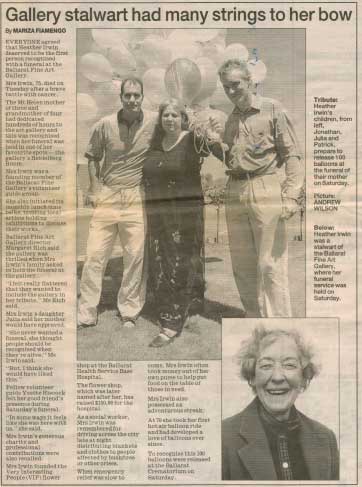
Main photo: Heather Irwin's children, from left,
Jonathan, Julia and Patrick, prepare to release
100 balloons at the funeral of their mother.
Everyone agreed that Heather Irwin deserved to be the first person recognised with a funeral at the Ballarat Fine Art Gallery. Mrs Irwin, 75, died on Tuesday after a brave battle with cancer.
The Mt Helen mother of three and grandmother of four had dedicated hundreds of hours to the art gallery and this was recognised when her funeral was held in one of her favourite spots — the gallery's Heidelberg Room.
Mrs Irwin was a founding member of the Ballarat Fine Gallery's volunteer guide group. She also initiated its monthly lunchtime talks, inviting local artists holding exhibitions to discuss their works.
Ballarat Fine Art Gallery director Margaret Rich said the gallery was thrilled when Mrs Irwin's family asked to hold the funeral at the gallery.
"I felt really flattered that they wanted to include the gallery in her tribute," Ms Rich said. Mrs Irwin's daughter Julia said her mother would have approved.
"She never wanted a funeral, she thought people should be regocgnised when they're alive," Ms Irwin said. "But I think she would have liked this."
Fellow volunteer guide Yvette Hiscock felt her good friend's presence during Saturday's funeral.
"In some ways it feels like she was here with us,"she said.
Mrs Irwin's generous charity and professional contributions were also recalled. Mrs Irwin founded the Very Interesting People (VIP) flower shop at the Ballarat Health Service Base Hospital. The flower shop, which was later named after her, has raised $150,000 for the hospital.
As a social worker, Mrs Irwin was remembered for driving across the city late at night distributing blankets and clothes to people affected by bushfires or other crises. When emergency relief was slow to come, Mrs Irwin often took money out of her own purse to help put food on the table of those in need.
Mrs Irwin also possessed an adventurous streak. At 70 she took her first hot air balloon ride and had developed a love of balloons ever since. To recognise this 100 balloons were released at the Ballarat Crematorium on Saturday.
Condolences to Heather Irwin's Family
(Click on an image to read.)
John Irwin's notes - May to October 2013
Heather's father, William Lyle Cochran was born in Ballarat. Date of birth would be easy to get. Probably about 1890. He was one of six brothers. I don't know where he fitted in the seniority table. Margaret thinks he went to school at MacArthur Street primary but I don't know if he went on to secondary school. At that time, if you passed your "merit certificate" at primary it was enough to start you in a wide range of clerical jobs. After schooling he worked for J.B. Woolcott, who was a member of the Ballarat Stock Exchange, which at that time was still very active. I don't think WC himself was a member.
He joined [volunteered - pi] the 1st AIF expeditionary force, probably in 1916 early months. [Heather used to say he did four years suggesting late 1914 or early 1915 - pi] That was post Galipoli and after preliminary training, probably in Royal Park Melbourne, he went to the Western Front, in France. He would have been deployed from a base in England. He was mustered to the Army Service Corp, which serviced the front line troops, mainly from horse drawn wagons, although these were increasingly replaced by motor lorries after 1916.
He rose to the rank of sergeant, a very responsible, non-commissioned rank. He was probably found to be capable and good at getting things done and he was 2 or 3 years older than the majority of volunteers. Additionally, he had an assertive and challenging style of discourse in almost any conversation. These characteristics would not be a disadvantage in a military context.
When on leave in England officers & senior sergeants were often billeted on large estates which had the accommodation to cope with members. It is likely that it was in these circumstances that he encountered the hunting and fishing society and maybe their pointer dogs. When I knew him he had a very fine engraved barrel gun by the English maker Purdy (sporting gun makers to the Royal family) [Heather remembered a Browning shotgun being particularly self indulgent? - pi]. He imported his pointers from England with all the expense and hassle of quarantine for several month on arrival. He bred from these dogs and regularly won blue ribbons with their progeny at the Melbourne and Adelaide shows. He had a whacking great Dodge car with chromed vents inserted in its flanks to ventilate the boot in which he transported the dogs.
He was very proud of his Scottish forebears who had been “gillies” (a sort of shepherd) in the remote highlands. He became president of the Caledonian society in Ballarat and held that position for years in spite of internal schisms which tried to displace him.
The news agency in Lydiard Street held the Ballarat franchise for “The Herald” - a very widely read paper in Ballarat which was brought up every afternoon from the the Herald office in Flinders Street (still there) by Mr Osborne which picked up bails of the Herald every day at 4 PM to get it to Cochran’s by 6 PM when deliveries began. [Heather also recalls WC exclaiming about deliveries by a certain Reginald Ansett who was apparently often late en route to the West, [perhaps he was taking on too much? - pi]. Half Ballarat took the Herald in the evening as well as the Age in the morning, we did so at Lydiard Street. The Lydiard Street newsagent was a money spinner, as well as an excellent location for lobbying and networking with mates, especially as Wallace relieved old Bill from any real responsibility or detailed attention to the business.
To revert to old Bill’s early years on return from the 1st World War his Ballarat job had disappeared and he moved to Kyneton, where he met Hilda Woolcock. He married her in 1920 and I think it was then that he got into the News agency business.
Wallace was born in Kyneton in 1921, Phyllis in 1922, Heather in 1925 and Hilda in 1927. Margaret was born in Ballarat in 1931 at Norwood private hospital in Webster Street.
The premises in Lydiard Street which became the Cochran news agency was owned by Wilfred Gooch, who lived in a fairly grand house near Cardigan - about half way between Ballarat and Burrumbeet. My mother was an acquaintance of Mrs Gooch, both, I think in a bridge playing circuit which included them as well as Muriel Henze, my mother’s life long friend.
Wilfred Gooche’s business was in the shop which later became Cochran’s News agency. Wilfred was nominally a stockbroker but in fact made a very good living as an SP bookie. These were illegal bookmakers who did not set the odds for the races on which they accepted bids. They accepted - or declined - the offer of bets at the odds set by legal bookmakers, so they essentially made their bets or not on their judgement of the legal bookmaker’s decisions. The advantage was that they carried no licensing fees or other imposts to which legal bookmakers were subjected; also they did not have to be at the racetrack. The disadvantage was that it was an illegal activity which attracted fines and was occasionally the object of a police blitz.
When the Cochrans moved back to Ballarat, after their post 1st World War exile to Kyneton, all the illegal betting business in the Lydiard Street shop was stopped and the news agency was expanded to include a much wider range of papers and magazines. It prospered. They did not on first return to Ballarat go to 211 Mill Street. For some years they lived in Devon Street, off Wendouree Parade, on the corner of Lake Street. Heather and, I think Hilda, went to Pleasant Street Primary, which was within walking distance of Devon Street. I’m not sure when they moved from Devon Street, but the Mill Street house was a step up in that it was bigger and more comfortable, with a big tree shaded back yard, where there was room for the dog enclosure, and a good sized side drive with a garage. Margaret now occupies and I assume owns the house. If you visit the house you see the house Heather grew up in, virtually unchanged.
William Lyle Cochran was a tall man - probably 6’3” or 6’4” in the measurement of the time. He was lean, thin in the face, usually dressed in a suit with a waistcoat. He had his clothes taylor made, as many men did at that time. He was always a conventionally well dressed business man. He grew up at the time when the convention of manners for men was laconic, but also a bit on the assertive side. He was assertive. My father played football for Ballarat North and many times competed with Bill Cochran. My father said he was hard to beat in the packs. All knees and elbows, my father said, and aggressive [At this time they would have been 16 or 17]. I don’t want to get into amateur psychology but I have wondered often about the effect of the 1st World War on him. As I have said he was in the Army Service Corp, servicing the front trench lines. They would have been frequently hammered by artillery from the other side and there must have been huge casualties among the horses: A horse can’t go to ground and pull on a steel helmet. They would be tragically vulnerable to shrapnel.
Anyway, this didn’t have the affect on him of never again wanting to kill anything. He continued into comparative old age as a scourge to rabbits, hairs, foxes, plovers, ducks, quayle etc.
Mrs Cochran, addressed by Bill always as “Hilda” was a very subdued unassertive person, and very much a restrained personality. She seemed to me, in contrast to my mother, to have a very limited social life and was rarely out of the house to other women’s houses. No one was permitted to address her, or to refer to her, as “mum”. She insisted, backed by Bill, on being addressed as “mother” and none of the children would have dreamed of calling her Hilda. Heather was astonished when she first “came to tea” at Lydiard Street to hear Nell addressed as Nell, Nellie, Mum & Nellie dear, never “mother”.
Heather had a mild bilateral astigmatism. She squinted a lot when reading. When I asked her about this she told me that she saw most objects as two objects, somewhat overlapping. For example she had never seen the moon as a single object, always two, fuzzy and overlapping. I think it’s amazing that she was a pretty good hockey player with this uncorrected disability. This was about the time I returned from my mandatory three term exile to Mildura, we had decided to get married at the end of first term: This gave me a sense of some kind of privileged authority and I insisted on her having her vision tested professionally. This led to her first glasses which transformed the world for her [Heather’s story was that she wore glasses from early childhood? - pi]. She saw a single un-blurred moon for the first time. I was on delicate ground with old Bill, who would have been perfectly capable of forbidding association between us. I was incensed by his self indulgence - guns, cars, imported dogs, tailored Scottish tweed suites etc but Heather could only play tennis as school if she borrowed a racket and runners. She was only at Clarendon because she had won a full scholarship, otherwise, I believe she would have been drafted to help in the shop and the home.
Hilda was full time in the shop until she married. Margaret was indulged and allowed to work at Taylor’s Pharmacy and study to become a pharmacist herself. Wallace was full time in the shop, and it was he who pushed it along. For example, he talked the old man into buying a van to service a network of branch sub news agencies in milk bars and fruiterers etc for both morning and evening papers. My father and mother were very attached to Heather quite soon and they helped me to help her.
Heather was an omnivorous reader from an early age, and I think that would give her a useful edge over the competition and she won a full scholarship from Pleasant Street to Clarendon. As you probably know my mother and my sisters Jean and Alison went to Clarendon. Jean won the exhibition in English in her last years there.
I first met Heather at school mid term dance in the winter of 1941. I danced with her exclusively and discovered that she was really literate and had a wonderful memory for quoting poetry and often other texts as well. She had been at Clarendon from the end of primary school at Pleasant Street. Successes at Clarendon included winning the Coulter cup for excellence academically and at sport and being dux in both 42 & 43. From Clarendon Heather won a full residential scholarship to the Women’s part of Trinity, Janet Clarke Hall and an academic scholarship to the University.
She loved it there and made many good friends. I was demobilised form the Navy while Heather was at JCH and our lot of discharged servicemen who had matriculated 3 or 4 years before were offered refresher courses, especially in physics, chemistry and where appropriate, mathematics. This was over the 3rd term of the year, our lot being scheduled to go up to Mildura at the start of the next academic year. That was for medicine, dentistry, engineering and architecture and I think arts degrees majoring in maths. Anyway, during the refresher course in third term I lived at Greycourt, a converted Royal Parade Mansion, which offered accommodation to non college 1st year entries. So, Heather was over the other side of Royal Parade, while I was at Greycourt. Hot water was rare at Greycourt and due to the combined efforts of Heather and her Janet Clark Hall friends I was routinely smuggled into Janet Clark Hall in the evenings for a hot shower. Reputedly the first male to get beyond the front entrance hall. It required about 5 residents to be lookouts at various points and a couple more to stage a distraction if authorities approached. Heather really enjoyed JCH and made many good friends. Pat Phillips, Barbara James and one other who majored in biology and became an authority on bees and butterflies and whose name at the moment escapes me.
Heather did a combined course of arts and a social work diploma. A single subject in the arts course troubled her - I think it was industrial relations (maybe Margaret would remember?). She failed the subject twice, having passed or got honours in the other subjects - but it prevented her taking out the arts degree, I think, but not the social work diploma.
Her first job was at Kinnear’s rope factory - as a social worker (must have been a large work force). It was on Ballarat Road, Footscray and I could pick her up after 5 O’clock when we went to Ballarat, which was just about every weekend. I had an 8 HP Morris with a canvas top. Frank and Beth Ritchie often came with us - Frank and Heather both with notable singing voices would improvise descants on popular songs - they were great but slow journeys, 2nd hear over a lot of the Pentland Hills.
Heather and I had been married early in my 2nd year (1947) when I returned from Mildura. I got an annual book allowance under the terms of the Rehabilitation Scheme which supported ex service people doing occupationally oriented training. It also paid 3 pounds a week living allowance (a low interest loan), which was totally inadequate for single people not living at home. I supplemented it by working in the holidays as a bricklayers labourer, with Hansen & Yunken. The labourer delivered the bricks by the barrow load to the brickies, also the mortar, by the barrow load from the central mortar mixer. One labourer to two brickies, so on straight going brickwork it was flat out.
Great relief when they got to a window embrasure or a chimney. I worked on a couple of comparatively high rise buildings - 3 or 4 stories. The money was good, but it was hard on the hands. Most of my fellow students amount the meds and dentels (universally called deads & mentals) worked in shops - especially Myers - for half the money. Heather, by this time has left Kennear’s Ropes and was working for the Kindergarten Association. We lived in half a house in Aintree Road, Glen Iris, shared with another couple; the man was a driver for a furniture removing company. I forget what his wife did. They were very agreeable easy going people but not friends.
Most of our social life was with Frank & Beth Ritchie, who lived amount the gum trees in Croydon.
At weekends we often shared meals - usually Saturday night - scrambled eggs on toast, sausages & mashed potatoes, a rather unsophisticated casserole called Lancashire Hot Pot, garnished to an economical extent with cut up rump steak and filled out with lots of little potatoes, carrots and cubes of pumpkin. We drank beer if there was enough budget latitude, but at that time not wine. It was the advent of cask wine that turned us in that direction. It was a bit cheaper than beer, but came in large casks, and due to the newly established collapsing plastic bladder, it would keep and could be bought by the gallon but that was much later, in the 1960s.
Returning to Ballarat we bought the Mount Clear site, some 2 ha, 6km out of town in about 1948. People thought we were mad being so far out where services would be difficult. House
construction started in about 1949 and proceeded at an agonising rate, largely because of materials being in short supply (it took two years to get a bath), but also, Heather remembered because of the builder being in the early stages of a deteriorating illness.
While all this was going on we rented a house on the corner of Eyre and Pleasant Streets belonging to an old school friend of Heather’s who had gone to England for a year. When they returned we lived for a couple of months, at least, in a rented house in Gregory Street, until we at last moved into Mount Clear before the living room floor was done and before the house was painted and long before connection to town water. Our first hot water supply was a kerosene heater which served at least until the 1970s later boosted by an electric service.
Services came slowly, I put the first water supply line in by ploughing a furrow with a borrowed horse and plough (from Eddie Hart) some 800m from the Mount Clear Post Office and putting in a line with some kind of tacit agreement with someone from the Ballarat Water Commission that may not have been in rigorous compliance with all the regulations. As far as I know that line is still in service but gas did not follow until the late 1970s.
During this period we also acquired Benjamin, a wilful golden labrador of great charm. He was impossible to contain in an unfenced property and roamed freely across dangerous lands and roads. We look him everywhere with us and he enjoyed swimming and could dive to considerable depths to retrieve.
When we left for England in 1954 or 55 we rented the house to ?? and also left Benjamin in their care. Tragically they reported he disappeared one day and never came back.
When we arrived in England we had a worrying margin financially and I had to get a paying job quickly. I applied for a job as a senior registrar at Bristol Royal Infirmary, a big and very traditional teaching hospital and I only got the job because I agreed to accept it at a junior resident salary, which was a bit sparse because we had to rent accommodation of course and we also wanted to buy a car. Heather didn’t try for anything in social work but got a reasonably paid job at Parker Furniture as a sales person in one of their large emporiums in Bristol. She liked the furniture they made and it was well regarded and virtually sold itself so that worked out well. She got Saturday’s off and being a registrar in orthodontics I was never rostered for weekends at the Infirmary. That fell to the surgical lot. They were terrifyingly well qualified by Australian or American standards:
Most had dental and medical qualifications and usually Fellowships of RCS as well.
The car we bought (for sixty pounds) was a 1937 Ford 10. It remained trouble free and reliable for all we did in it until it broke the front beam axle when I took it onto a side road while climbing from Italy to Austria via the Brenner Pass, over the Alps. I wired it up with a wooden splint and we crept the last few kilometres until we found an Austrian blacksmith who welded it up for us.
....to be continued
